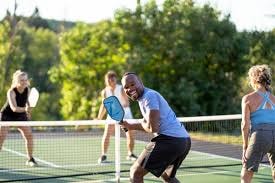
Pickleball is a popular paddle sport that blends elements of tennis, badminton, and ping-pong. It can be played one-on-one (singles) or two-on-two (doubles), with doubles being the most common format. New players pick it up quickly – as Dr. Ernie Medina notes, beginners often learn the basics “in an hour or two” and are “out on the court…immediately playing a match”. The game is highly inclusive: players of all ages and abilities can compete. In fact, pickleball supports adaptive play, and many wheelchair and hearing-impaired athletes enjoy it. Pickleball has also grown rapidly worldwide; the International Pickleball Federation (IPF) publishes a global rules guide to unify play.
Pickleball Rules: Understanding the Court and Equipment
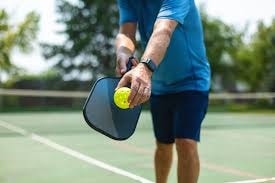
A standard pickleball court is a rectangular area 20 feet wide by 44 feet long (including boundary lines). This is identical in size to a badminton doubles court, though smaller than a tennis court. The court is marked by a centerline, sidelines, baselines, and a non-volley zone line (7 feet from the net on each side). The net spans the court’s width: it stands 36 inches (3 feet) high at the sidelines and 34 inches high at the center. All court lines are 2 inches wide (USA Pickleball standard) and a ball contacting any part of a line is considered “in” with the notable exception that a serve hitting the non-volley-zone line (the “kitchen” line) is short and therefore a fault. For a serve to be valid, it must land in the opponent's court, specifically in the correct service area, and not in the non-volley zone.
Image: A pickleball (yellow ball) on a blue court, illustrating court lines. Players use paddles and balls designed specifically for pickleball. The paddle is a solid face (graphite, composite, or wood) attached to a handle; it must meet USA Pickleball size and weight standards. Modern paddles often have a widebody shape to increase hitting surface. A pickleball is a lightweight plastic ball with holes: indoor balls typically have 26 holes and are softer, while outdoor balls have 40 holes to withstand wind. Balls come in bright colors (yellow, green, orange) for visibility. For example, some balls are fluorescent orange (3 holes per row, usually 40 holes total). Players also wear court shoes, shirts, and shorts; no spikes are allowed.
Court Lines and Zones
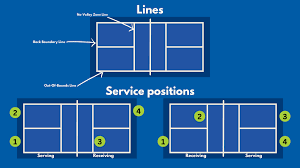
The court is divided into specific zones: on each side, two 10-feet-wide service courts flank the centerline, and a 7-foot-deep non-volley zone (kitchen)—commonly referred to as "the kitchen" by players—lies closest to the net. The non-volley zone extends 7 feet from the net on each side (making it 14 feet of court width total)usapickleball.org. Volleying (hitting the ball in the air without letting it bounce) is not allowed while standing in the non-volley zone; doing so is a fault. In other words, players may only volley a ball outside this zone or after it has bounced in the zone. Stepping on the line itself counts as being in the zone, so if a volley is made while touching or entering the kitchen, it is a fault This rule prevents overpowering smashes at the net. Players may enter the kitchen to play a bounced ball (a drop shot, for example), but must wait until after striking a volley before stepping in, and momentum cannot carry them into the kitchen during a volley.
Paddles and Balls
Pickleball paddles typically measure about 8 inches wide and 15–16 inches long, with weights around 7.5–8.5 ounces for composite paddles. Paddle faces have no holes (unlike ping-pong paddles). For beginners and children, lighter paddles (under 7.5 oz) can ease play. Pickleball balls are hollow plastic spheres 2.87 inches in diameter (USAPA standard), slightly smaller than a wiffle ball, with holes to reduce speed and wind drift. There are outdoor balls (typically orange or yellow with 40 holes) and indoor balls (typically white or lighter-colored with 26 holes) Any ball meeting USA Pickleball’s size and weight criteria is legal. For example, indoor balls often bounce higher and slower, making them preferred on gym floors, while outdoor balls bounce lower and move through air better.
Game Format: Singles and Doubles
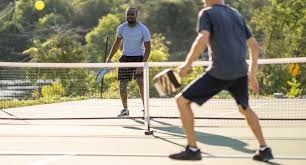
Pickleball can be played singles (one player each side) or doubles (two players each side) The court size is the same for both formats. In doubles, teammates stand on opposite halves and can switch sides only during service as dictated by the score. In singles, players use the same court and follow similar serving rules, but the serving turns alternate differently since there are no partner turnovers. Specifically, when playing singles, the server stands on the right side of the court when the score is even and on the left when odds. The same general rules apply: underhand serve, two-bounce return, kitchen restrictions, etc. All the rules of pickleball apply to both singles and doubles unless otherwise specified. Doubles players benefit from teamwork: one common strategy is that one player holds the net line (ready to volley) while the other covers the baseline.
Serving Sequence and Rotation
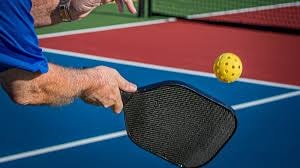
The service sequence in pickleball determines the order in which players serve in both doubles and singles play. Understanding the service sequence is crucial for following the flow of the game and keeping track of scoring and serve rotation.
The serve always starts from the right-hand (even) side of the court for each team. In doubles, the first server is the player who serves at the beginning of the game. During this initial service sequence, only one partner is allowed to serve before the serve switches to the opponents. Under traditional side-out scoring, play begins with only one player serving; if they fault (make an error), the serve immediately switches to the other team, and then both players on that team get a turn to serve (until they fault twice) After each fault, serve switches sides. Example: Team A starts serving from the right court. If Team A scores, the same server switches to the left court and continues to serve (and score) until they fault. The serving team's score determines which side the server stands on: even scores serve from the right, odd scores from the left. The serving team's score is always announced first before each serve. Upon fault, the second server (the partner) serves next (from their correct side), then the other team gains the serve after two faults. In contrast, rally scoring (optional in some tournaments) awards a point on every rally, not just to the serving team.
Image: Pickleball paddles and balls ready for play (beginner equipment). In practice, beginners often use simplified cues: serve underhand from behind the baseline to the diagonally opposite service box.. The first serve of each game in doubles (sometimes called the “starting” serve) is special: only one fault is allowed before a side-out, unlike the usual two faults (one per partner). After the initial service sequence, normal two-server play resumes, with the first server and second server alternating as faults occur. If a team wins a point, the same player serves again, switching sides (right/left) according to the score. If the server loses the rally (faults), serve goes to the appropriate partner or opposing team. In singles, only one player serves; after a fault, the other player serves from the side corresponding to their score parity.
Fundamental Rules of Play
The rally (the exchange of shots) follows simple principles. The Two-Bounce Rule (Two-Bounce Rule) is fundamental: the receiving side must let the serve bounce once before returning, and then the serving side must let the return bounce once. After each team has hit the ball off a bounce once, the ball is “live” and either team may volley (hit in mid-air) or play it off a bounce. At this point, the point continues until a fault or a winning shot is made. This rule ensures longer rallies by preventing immediate volleys at the net on the serve or return. A common beginner tip is “bounce-bounce-volley”: let two bounces occur (one per side) before volleying.
Volleying (hitting in the air) is allowed only when the player is outside the non-volley zone. Once the ball bounces at least once on each side, players can choose to volley or play a groundstroke on each shot, but they must respect the kitchen boundary. If at any time a team hits the ball incorrectly (serving or playing off the bounce instead of letting it bounce once per side), that is a fault.
Scoring
Pickleball uses a score-keeping system unique to the sport. Under traditional side-out scoring, only the serving team can score points. Games are typically played to 11 points, win by 2 (though tournament games sometimes go to 15 or 21) The scoreboard counts the serving team’s points. If the serving team wins the rally, they score a point and the same player (or partner) serves again from the other court side. If the serving team faults (loses rally), they score no point and serve passes to the opponent (side-out). In official doubles play, teams often rotate servers, but the partner’s fault handling is unique as noted.
For example, Good Housekeeping summarizes the scoring simply: “Points are scored by the team that serves, and you play to 11 points. A team has to win by 2 points.”goodhousekeeping.com. To win points, a team must be serving and win the rally. Some newer tournaments allow rally scoring, where every rally yields a point regardless of which side serve. This speeds up play. In rally scoring, both teams can score on any rally (often up to 15 or 21 points to win). However, recreational and most amateur games still use the traditional side-out style.
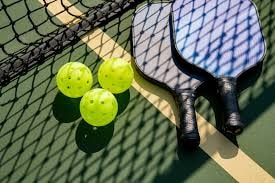
In gameplay, the server always announces the score before serving (e.g. “3-1-2” meaning serving team's score is 3 points, receiving team 1, and it’s the second server’s turn). Game calls are important in pickleball; players must announce the score and server number before each serve to keep everyone synchronized. Mistakes in calling the score are rare but typically must be corrected before serve. If a wrong score has been played out, it is correctable before the next point; once the ball is served, the score is final for that rally. Any ball that touches the boundary lines is good, and only a shot landing completely outside the court is out.
The Serve
The pickleball serve is the action that starts each rally in the game. To serve the pickleball game, the server must use the correct technique: the serve must be underhand. The server strikes the ball with a paddle swing that is in an upward arc, and the contact point of the paddle must be below the server’s wrist and below waist level at the moment of impact. This means you cannot “slam” the ball from above your shoulder; the stroke is similar to a gentle arching swing. As USA Pickleball’s summary states: “Paddle contact with the ball must not be made above the waist level”usapickleball.org. The server must also keep at least one foot behind the baseline (and not touching the baseline or in the court) Feet can move but cannot touch the court during the serve – one must remain on or behind the baseline.
The ball must be hit into the diagonally opposite service court for the serve to be valid. That is, a server on the right side must serve to the opponent’s right (from their view), and vice versa. The first serve of each point is made from the right-hand court if the server’s team has an even score, and from the left court if odd (in both singles and doubles). Only one serve attempt is allowed; there are no second-serve “lets” or do-overs (except that many players ignore let calls on serves that clip the net but still land in). If the serve lands in or out of bounds incorrectly, that is a fault. Specifically, a serve must clear the net and drop in the receiving team’s diagonal court; hitting the kitchen or kitchen line is a fault, and hitting outside the court is out.
Good Housekeeping highlights the key points: “When you serve the ball, you must hold the paddle and the ball below your waist, and serve underhand. … You serve diagonally cross-court. While serving, you have to keep your feet from touching the court or the sideline area, and keep at least one foot behind the baseline." These strict serve mechanics ensure a level playing field. Additionally, a drop serve (where the server drops the ball and strikes it after it falls) is permitted under newer rules, and in that case the underhand requirement does not apply.
Serving Sequence and Rotation
When a doubles team earns the serve, one partner (Server #1) starts on the right side and serves (with proper foot placement) If Server #1 wins the rally, that player scores a point and then serves again from the left side. Server #1 continues switching sides after each point and serving until they fault. When a fault occurs, the serve passes to the next server or the opposing team, depending on the sequence. Once Server #1 faults, service passes to their partner (Server #2), who serves from whichever side is correct for the team’s score. Server #2 will then continue to serve (switching sides after points) until that team faults again. After the second fault by a team (one fault by each partner), serve goes to the opponents (side-out).
In other words, in doubles, each partner gets a turn to serve in a side-out except on the very first service of the game (where only one person serves once). Good Housekeeping explains: “Players serve until they commit a fault… With the first serve of the game, that team gets only one chance to serve (until they commit a fault). But the opposing team then gets a chance for both players to serve… meaning until their team makes two faults.” After those first two faults (one per team), the pattern continues: both players serve until their team faults twice, then the serve rotates.
In singles play, the rotation is simpler: a player serves from the right (even score) or left (odd score) as noted, and only one server exists. After each point or fault, serve alternates to the opponent.
Two-Bounce Rule
A defining feature of pickleball is the Two-Bounce Rule (also called the Double Bounce Rule). This rule states that on every rally’s beginning, each side must allow the ball to bounce once before playing it. Specifically, the receiving teammust let the serve bounce in the opponent's court, and then the serving team must let the return bounce. These are the first two bounces. After those two bounces have occurred, the ball is live and either team may volley or ground-stroke. In short: “Each side has to let the ball bounce once before returning it.”
This rule prevents a serve-and-volley exchange from immediately dominating play, giving both teams a fair opportunity to engage in the rally. Once the two bounces have happened, players may choose to volley (hit it before it bounces) or play it off a bounce according to strategy. It is a fault, however, if a player volleys too early (before the two bounces have occurred)
Non-Volley Zone (Kitchen)
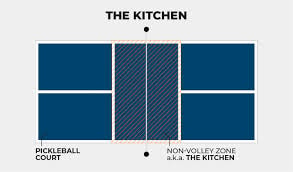
The non-volley zone (NVZ), commonly called the “kitchen,” is the 7-foot area closest to the net on each side.The kitchen is strictly a no-volley zone. Players cannot volley (hit the ball in the air) while any part of their body or paddle is in or on the kitchen line. In other words, one may only strike a ball (by volleying) when standing behind this line or when hitting a bounced ball that has already touched in the NVZ. Volleying within or touching the NVZ is a fault.
For example, Good Housekeeping clarifies: “There’s a zone called ‘the kitchen’ within 7 feet on both sides of the net… This is the ‘no-volley’ zone — meaning you can only hit a ball from this zone if it bounces first. If you hit a volley when standing in the kitchen, it’s considered a fault. It’s also a fault if you accidentally step into the kitchen after hitting a volley, even if it’s just momentum that sends you there.”goodhousekeeping.com. This means that after a volley swing, if momentum carries you into the kitchen (even after the ball is hit), it is still a fault. However, players may enter the kitchen at any time if they are not volleying. For instance, a player can run into the kitchen to hit a dropped ball (one that bounced first). They just cannot volley while in or landing in that zone.
The kitchen rule keeps play fair at the net and prevents power smashes that leave no reaction time. It also adds an important tactical element: “dinking” (soft shots that land in the kitchen) and positioning around the kitchen line are critical skills at all levels. Advanced players often engage in long “kitchen duels,” hitting drop volleys (volley after a bounce) to force opponents into tricky plays near the net.
Image: A pickleball paddle and an “indoor/outdoor” hybrid ball.
When serving, a ball landing in the kitchen on the serve is a fault (short serve). Additionally, if a ball is volleyed into the net or out of bounds, or if it bounces twice (which signals a “double bounce” fault), play stops and a fault is called. The rally ends on any fault.
Faults
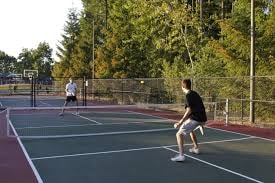
A fault in pickleball is any violation that stops play and awards the point (or serve change) to the opponent. Common faults include:
-
Serving faults: Serve out of bounds, serve into the net, serve landing in the kitchen (non-volley zone) or outside the diagonal service court.
-
Volley faults: Volleying the ball before the two bounces (violating two-bounce rule), volleying from inside or touching the non-volley zone (the kitchen)
-
Bounce faults: Letting the ball bounce more than once on your side (double bounce) or hitting the ball before the bounce on a return (breaking the two-bounce rule)
-
Out-of-bounds: Hitting a ball that lands outside the court lines (outside or beyond the sidelines, baselines, or centerlines).
-
Net faults: Touching the net or net post with your body, clothing, or paddle while the ball is in play.
-
Miscellaneous faults: Any violation of service rules (feet placement, paddle position) or a played ball hitting a permanent object before bouncing in the court.
When a fault is made by the receiving team, the serving team scores a point; if the serving team faults, they lose the serve (side out). For example, if the server hits the ball into the net or out of bounds, serve immediately passes to the opponents. If the receiver commits a fault (say, volleying too early), the server gains a point. This scoring change distinguishes side-out scoring in pickleball from tennis (where both sides can score on each serve).
Singles vs. Doubles Rules
The fundamental rules of pickleball (serving, scoring, kitchen, faults, etc.) apply to both singles and doubles play. However, there are slight differences in scoring rotation and court coverage between the two formats. In doubles, the serving sequence and partner rotation are as described above. In singles, each player serves alone: the server scores as usual if they win the rally, and after a fault by the server, the opponent takes the serve (no partner switch is needed). The serve always starts on the right side for each player when they have an even score, switching to the left side if the server’s score is odd.
Court positioning also differs. In doubles, teams often adopt a “one up, one back” stance at the net and baseline. In singles, a solo player must cover the entire court and will frequently volley at the net or sprint to hit lobs. Because of this, singles rallies may be longer and involve more running. However, doubles tends to be more strategic volley-for-volley. Officially, there is no difference in rules for the kitchen, serve, or scoring between singles and doubles – only the rotation and strategy change.
Learning and Player Levels
Pickleball is accessible for beginners yet offers depth for advanced players. Beginners should focus on mastering the basics: underhand serving, the two-bounce rule, and non-volley zone awareness. As beginners, players often make faults by serving too hard into the net or stepping on the kitchen line. Intermediate players refine their strategies: they try to gain net position (while respecting kitchen limits), learn shot placement (like drives, drops, and lobs), and keep rallies consistent. Advanced players know advanced shots (spin, placement), reflex volleys, and team movement.
USA Pickleball rates players by skill (1.0 to 7.0); the rules are the same across all skill levels, but tournament and club play may use stricter ball standards or specialty scoring. Professionals follow the exact same rules, often at very high speed, and physical fitness and strategy differences separate them.
Experts note that pickleball can be adjusted for fitness levels. As Medina says: “Pickleball is excellent for exercise, because it’s easily adaptable to any skill level. You can play it at a very high level of intensity if you want to get a really good workout.”goodhousekeeping.com. This makes the game appealing from casual to competitive play.
Adaptive Pickleball
Pickleball has become very popular among adaptive athletes. USA Pickleball publishes rules for wheelchair pickleballwhich modify some play areas (e.g., the no-volley zone is extended to players for safety) while keeping the sport inclusive. Similarly, deaf and visually impaired players often use communication signals (and other rule interpretations) to play. For example, as a recent rule change allows, players can use a verbal “not ready” signal to pause before serve. Dr. Medina highlights adaptive success: his 84-year-old mother earned a national medal, and many in the disabled community excel at pickleball. Whether standing or seated, the core rules (two-bounce, kitchen, faults) generally apply, with small adaptations for mobility.
International and Official Rules
The USA Pickleball organization (formerly USAPA) maintains the official rulebook for play in the United States. For international play, the International Pickleball Federation (IPF) provides a “Global Pickleball Rules” guide (2024 edition) to standardize rules. According to the IPF, their rulebook is a “passport to a game…providing unified rules for pickleball players around the world, from recreational to professional”theipf.org. In practice, the rules are nearly identical: an international tournament under IPF or USA Pickleball sanctioning will follow the same kitchen, serve, and scoring rules.
Where to find official rules: The current rulebook can be downloaded from USA Pickleball’s website (for example, see their Pickleball Rules Summary or detailed rules). The IPF website and USA Pickleball also publish clarifications and updates. Players are encouraged to review the official rulebook or summary before competition.
Recent Rule Changes (2025 Updates)
Pickleball rules evolve over time. USA Pickleball and IPF periodically approve changes. Notably, 2025 rule updatesintroduced clarifications and new protocols. For example, formal “not ready” signals are now allowed: a receiving team player may say “stop” or “wait” to indicate they are not ready after the score is announced. Previous rules ignored such signals, but the new change codifies sportsmanship, allowing rallies to pause without penalty.
Another update refines the definition of a volley and momentum. The rule now explicitly states that the act of volleying ends when the player’s momentum from the swing ceases play. This means that if a player’s follow-through before a volley carries them into the kitchen before hitting the ball, it isn’t a fault as long as they were out of the kitchen at the moment of striking. However, it clarifies partners must not make contact during a volley action near the kitchen.
The rule about disputed calls was also clarified. Previously, if partners disagreed on a fault (like a foot fault), a replay was required. Now, disagreements among teams (not partners) cause replays. If partners alone disagree, the point simply goes to the opponent. USA Pickleball explains this as ensuring any doubt benefits the opponents rather than forcing replay.
As rules continue to update, official publications (USA Pickleball web site, IPF site) note these changes. For the lay player, the core game is the same, but it’s good to keep abreast of official communications.
Strategy and Best Practices
While not strictly “rules,” strategic awareness and etiquette are important. Some key points:
-
Honor system: Players call their own line calls and faults. It’s expected that each side admits faults honestly. In tournament play, any player may call a fault on the opponent if seen.
-
Foot faults: Server’s feet must stay behind baseline; stepping on or over the line before contact is a foot fault. Similarly, if a partner’s clothing touches the net during a volley, it is a fault.
-
Line calls: If the ball hits a line on your side, it’s yours (i.e., “lines are in”). If unsure whether the ball was in or out, players usually give the benefit of doubt to the opponent (a friendly convention, not a formal rule).
-
Score announcement: It is standard etiquette to announce the score loudly and clearly before serving. This helps both sides keep track.
-
Sportsmanship: Players often say “good shot” to each other and must not distract the opponent during service.
Advanced players focus on aggressive net play (staying near the kitchen line to poach volleys) and soft dinks (gentle shots landing in the opponent’s kitchen). Keeping it in bounds and minimizing unforced errors (into the net or out of bounds) is crucial at all levels.
FAQ (Frequently Asked Questions)
Q: What are the basic rules of pickleball?
A: In pickleball, players use underhand serves that must land diagonally in the opponent’s service box. Each side lets the ball bounce once on serve and return (two-bounce rule) before volleys are allowed. A kitchen area (7 feet from net) is off-limits for volleying. Points can only be scored by the serving team under traditional rules. Games are normally played to 11 points (win by 2).
Q: How do I serve correctly in pickleball?
A: The server must hit the ball underhand, with paddle contact below the wrist and below the waist. One foot must stay behind the baseline (not touching it) during the serve. The serve goes diagonally into the far service court. Only one serve attempt is allowed (no second serve). If the serve lands in the opponent’s kitchen or outside the court lines, it’s a fault.
Q: What is a fault in pickleball?
A: A fault ends the rally and either gives a point to the opponent or ends the serve. Faults include: hitting the ball out of bounds; volleying the ball from inside the kitchen (or touching the kitchen line during a volley); allowing the ball to bounce twice on your side; violating serve rules (foot faults, kitchen serve)usapickleball.org; or touching the net with any part of the body or paddle during play. A serve that hits the kitchen is also a fault.
Q: Can a ball that touches the line be considered in?
A: Yes. Any ball that contacts a boundary line (sideline, baseline, centerline, or kitchen line except on serve) is considered “in”. For example, a shot that clips the baseline is good. The only exception is the kitchen line on a serve: if the serve touches the kitchen line, it is short and is a fault.
Q: How do I keep score?
A: In doubles, only the serving team can score (traditional side-out scoring). When your team serves, you earn a point by winning the rally. The score is announced as “(serving team’s score) – (receiving team’s score) – (server number, 1 or 2)”. Games usually go to 11 points, win by 2. In rally scoring formats (optional in some tournaments), a point is awarded on every rally, no matter who served. Always state the correct score before serving. Many beginner games also play “win by 1” as a friendly rule, but official play requires win by 2.
Q: Where can I find the official pickleball rules?
A: The official rules are published by USA Pickleball and by the International Pickleball Federation (IPF). USA Pickleball’s rulebook and quick-reference summary can be downloaded from their website. The IPF’s 2024 rulebook also provides unified global rules. For example, USA Pickleball’s Pickleball Rules Summary outlines the serve, scoring, and faults. It’s best to review these official sources for any clarifications, especially before tournament play.
Q: Is pickleball just for older people or can kids play too?
A: Pickleball is truly a sport for all ages. Younger players often excel due to quick reflexes, while older players appreciate the smaller court and social nature. In fact, there are junior (youth) tournaments, as well as seniors and masters divisions. The rules do not change for age – a 10-year-old follows the same serve and kitchen rules as an 80-year-old. Dr. Medina’s family example (a grandma winning medals) illustrates how age doesn’t limit the game..
Q: What equipment do I need to start playing?
A: At minimum, you need a paddle and a ball. Beginner kits often include two paddles and a set of pickleballs, plus a net you can set up. Pickleball paddles are relatively affordable compared to many racket sports. The official rules specify only that equipment must meet certain size and material criteria (approved ball diameter, etc.), but any commercial pickleball paddle and ball will do. For better performance, choose a paddle and ball suited to your level (lighter paddles for kids, indoor/outdoor ball depending on surface). Good court shoes with non-marking soles are highly recommended.
Q: How is pickleball different from tennis or ping-pong?
A: While pickleball shares features with tennis, table tennis, and badminton, key differences are:
-
Court size is much smaller than tennis, making pickleball less demanding on endurance and easier to cover.
-
Pickleball uses a paddled racket (hard, flat) like a big ping-pong paddle, instead of stringed racquets or small ping-pong paddles.
-
The ball has holes and is slower; serves are underhand only (ping-pong allows overhand topspin serves).
-
Scoring and rules differ: e.g. tennis allows volleys anywhere, ping-pong has no kitchen. Pickleball’s kitchen and two-bounce rules give it unique strategy.
-
It’s typically doubles-oriented like badminton, and volley speed is fast like tennis but with lighter gear.
Q: What should I call if I see a fault or ball out?
A: If you clearly see the opponent’s shot is out, it’s common courtesy to say “out” (some play without it, but sportsmanship encourages calling obvious errors). Faults and line calls on your own shots are typically yours to admit. The official rules put no penalty on self-reporting a fault; indeed, players are expected to follow the honor system. If an opponent calls a fault on you (e.g., foot fault or kitchen violation) and you disagree, review the play calmly. New rules now say partner disagreements go to opponents (so if one partner thought you foot-faulted and the other thought not, the point goes to them)playpickleball.com.
Q: Are there resources or apps to keep score and learn rules?
A: Yes. USA Pickleball’s website has PDF rulebooks and summaries. The official app (if available) and various pickleball apps can track scores for you. Many instructional videos and free guides are online. Additionally, local pickleball clubs often offer clinics. For quick cheat-sheets, some organizations publish printable PDFs of rules or point-by-point checklists (see downloadable assets below).
Line Calls
Line calls play a crucial role in every pickleball game, as they determine whether a shot is in or out of play. When the ball lands close to a boundary or the non volley zone, it’s up to the players on that side of the court to make a clear and honest line call. If there’s any uncertainty, players can consult their opponents or, in tournament play, ask a referee for a ruling. Good sportsmanship is key—if you’re not sure, it’s customary to give the benefit of the doubt to your opponents. During play, the server continues serving as long as their team wins points and avoids faults. Once a team commits a fault, the service passes to the receiving team, and the rotation continues. Accurate line calls help keep the game fair and enjoyable for everyone on the court.
Common Mistakes in Pickleball
Many new players make similar mistakes when learning the basic rules of pickleball. One of the most common errors is stepping into or standing in the non volley zone (kitchen) and attempting to volley, which is not allowed. Another frequent mistake is forgetting the two bounce rule: after the serve, the ball must bounce once on each side of the court before players can volley. Failing to let the ball bounce, or hitting it too soon, results in a fault. Communication is also important—players should call “mine” or “yours” to avoid confusion and collisions. Remember, only one serve attempt is allowed per point, and the server continues serving until their team commits a fault. Announcing the serving team’s score before each serve and understanding the serve and volley advantage will help you avoid unnecessary errors. By focusing on these basic rules and paying attention to the bounce rule and court positioning, you’ll quickly improve your game and enjoy more consistent rallies.
Tournaments and Leagues
Participating in pickleball tournaments and leagues is a fantastic way to challenge yourself, meet new people, and take your skills to the next level. Tournaments can range from friendly, recreational events to highly competitive matches with prizes and recognition for top players. Leagues offer a more relaxed, ongoing format, where you play a series of games over several weeks or months with others at your skill level. Registration for tournaments and leagues usually includes court time, equipment, and sometimes referees to help with line calls and rule enforcement. To find opportunities near you, check with your local community center, sports complex, or search online for pickleball events in your area. Whether you’re aiming for a trophy or just looking to have fun, tournaments and leagues are a great way to experience the excitement and camaraderie of the pickleball community.
Tournaments and Leagues
Participating in pickleball tournaments and leagues is a fantastic way to challenge yourself, meet new people, and take your skills to the next level. Tournaments can range from friendly, recreational events to highly competitive matches with prizes and recognition for top players. Leagues offer a more relaxed, ongoing format, where you play a series of games over several weeks or months with others at your skill level. Registration for tournaments and leagues usually includes court time, equipment, and sometimes referees to help with line calls and rule enforcement. To find opportunities near you, check with your local community center, sports complex, or search online for pickleball events in your area. Whether you’re aiming for a trophy or just looking to have fun, tournaments and leagues are a great way to experience the excitement and camaraderie of the pickleball community.
Common Mistakes in Pickleball
Many new players make similar mistakes when learning the basic rules of pickleball. One of the most common errors is stepping into or standing in the non volley zone (kitchen) and attempting to volley, which is not allowed. Another frequent mistake is forgetting the two bounce rule: after the serve, the ball must bounce once on each side of the court before players can volley. Failing to let the ball bounce, or hitting it too soon, results in a fault. Communication is also important—players should call “mine” or “yours” to avoid confusion and collisions. Remember, only one serve attempt is allowed per point, and the server continues serving until their team commits a fault. Announcing the serving team’s score before each serve and understanding the serve and volley advantage will help you avoid unnecessary errors. By focusing on these basic rules and paying attention to the bounce rule and court positioning, you’ll quickly improve your game and enjoy more consistent rall
Conclusion
In summary, pickleball is an engaging and accessible sport that offers something for everyone. By learning the basic rules—such as the two bounce rule, respecting the non volley zone, and understanding how the ball bounce affects play—you’ll set yourself up for success on the court. Avoiding common mistakes and practicing good sportsmanship will help you enjoy the game and improve your skills. Whether you’re playing for fun, joining a league, or competing in a tournament, pickleball provides a great way to stay active, connect with others, and challenge yourself mentally and physically. Remember to follow the rules, respect your fellow players, and most importantly, have fun every time you step onto the court.
Pickleball Court: Dimensions and Layout
A standard pickleball court measures 20 feet wide by 44 feet long, providing a compact playing area that encourages quick rallies and strategic movement. The court is divided in half by a net that stands 36 inches high at the sidelines and 34 inches at the center. On each side of the net, you’ll find the non volley zone—commonly called the “kitchen”—which extends 7 feet from the net toward the baseline. This area is crucial, as players are not allowed to volley the ball while standing in the non volley zone, helping to keep play fair and prevent aggressive smashes at the net.
Beyond the non volley zone, each side of the court is further divided into a right and left service court, separated by a centerline. When serving, the serving team must stand behind the baseline, making sure at least one foot remains behind the line until the ball is struck. The opposing team positions themselves on the other side of the net, ready to receive the serve. This layout ensures that both the serving team and the opposing team have clearly defined areas and responsibilities, promoting smooth gameplay and adherence to the basic rules of pickleball. Understanding the court’s dimensions and zones is essential for proper positioning, effective serves, and successful rallies on any pickleball court.
Equipment: Paddles, Balls, and Accessories
To play pickleball, you’ll need a few essential pieces of equipment: a paddle, a ball, and some helpful accessories. Pickleball paddles are crafted from lightweight materials such as graphite, composite, or wood, and feature a smooth, solid surface for consistent ball contact. The design of the paddle allows for quick reactions and precise control, making it easier to hit the ball accurately during fast-paced rallies.
Pickleball balls are made of durable plastic and are perforated with holes to minimize wind resistance and ensure a predictable, limited bounce. This unique design keeps the game dynamic and accessible for players of all skill levels. In addition to paddles and balls, players often use accessories like portable nets, court shoes with non-marking soles, and comfortable athletic clothing to enhance their performance and safety on the court. Other useful items include paddle covers for protection, ball machines for solo practice, and court bags to carry your gear. With the right equipment, you’ll be ready to enjoy the fast-paced action and social fun that pickleball offers.
Equipment: Paddles, Balls, and Accessories
To play pickleball, you’ll need a few essential pieces of equipment: a paddle, a ball, and some helpful accessories. Pickleball paddles are crafted from lightweight materials such as graphite, composite, or wood, and feature a smooth, solid surface for consistent ball contact. The design of the paddle allows for quick reactions and precise control, making it easier to hit the ball accurately during fast-paced rallies.
Pickleball balls are made of durable plastic and are perforated with holes to minimize wind resistance and ensure a predictable, limited bounce. This unique design keeps the game dynamic and accessible for players of all skill levels. In addition to paddles and balls, players often use accessories like portable nets, court shoes with non-marking soles, and comfortable athletic clothing to enhance their performance and safety on the court. Other useful items include paddle covers for protection, ball machines for solo practice, and court bags to carry your gear. With the right equipment, you’ll be ready to enjoy the fast-paced action and social fun that pickleball offers.
Types of Shots in Pickleball
Mastering a variety of shots is key to gaining a serve and volley advantage and keeping your opponents guessing. Drives are powerful shots hit after the ball bounces, typically from behind the baseline or mid-court, and are used to apply pressure or force errors. Drops are soft, controlled shots that land just over the net in the opponent’s non volley zone, making it difficult for the opposing team to attack. Dinks are similar to drops but are played even softer, aiming to land close to the net within the non volley zone, often leading to strategic exchanges at the kitchen line.
Volleys are shots taken out of the air before the ball bounces, usually executed near the non volley zone line but always with the player’s feet outside the kitchen. Lobs are high, arching shots that send the ball over your opponent’s head, forcing them to retreat and giving your team time to reposition. By mixing up these shots and paying attention to how the ball bounces, players can outmaneuver their opponents, control the pace of the game, and capitalize on serve and volley opportunities.
Pickleball Game Variations
Pickleball can be enjoyed in several formats, with singles and doubles being the most popular variations. In singles play, one player faces off against another, and each point begins with a single serve. The serving team’s score is announced before each serve, and the opposing team (or player) attempts to return the ball and win the rally. In doubles, two players team up on each side, and the serve alternates between partners according to the service sequence. The serving team continues serving as long as they win points, while the opposing team works to regain the serve.
Regardless of the format, the objective is to score points by winning rallies, with games typically played to 11 points and requiring a two-point margin to win. These variations add depth and excitement to the pickleball game, allowing players to choose the style that best suits their preferences and skill level, while always keeping the focus on teamwork, strategy, and friendly competition.
Conclusion
In summary, pickleball is an engaging and accessible sport that offers something for everyone. By learning the basic rules—such as the two bounce rule, respecting the non volley zone, and understanding how the ball bounce affects play—you’ll set yourself up for success on the court. Avoiding common mistakes and practicing good sportsmanship will help you enjoy the game and improve your skills. Whether you’re playing for fun, joining a league, or competing in a tournament, pickleball provides a great way to stay active, connect with others, and challenge yourself mentally and physically. Remember to follow the rules, respect your fellow players, and most importantly, have fun every time you step onto the court.
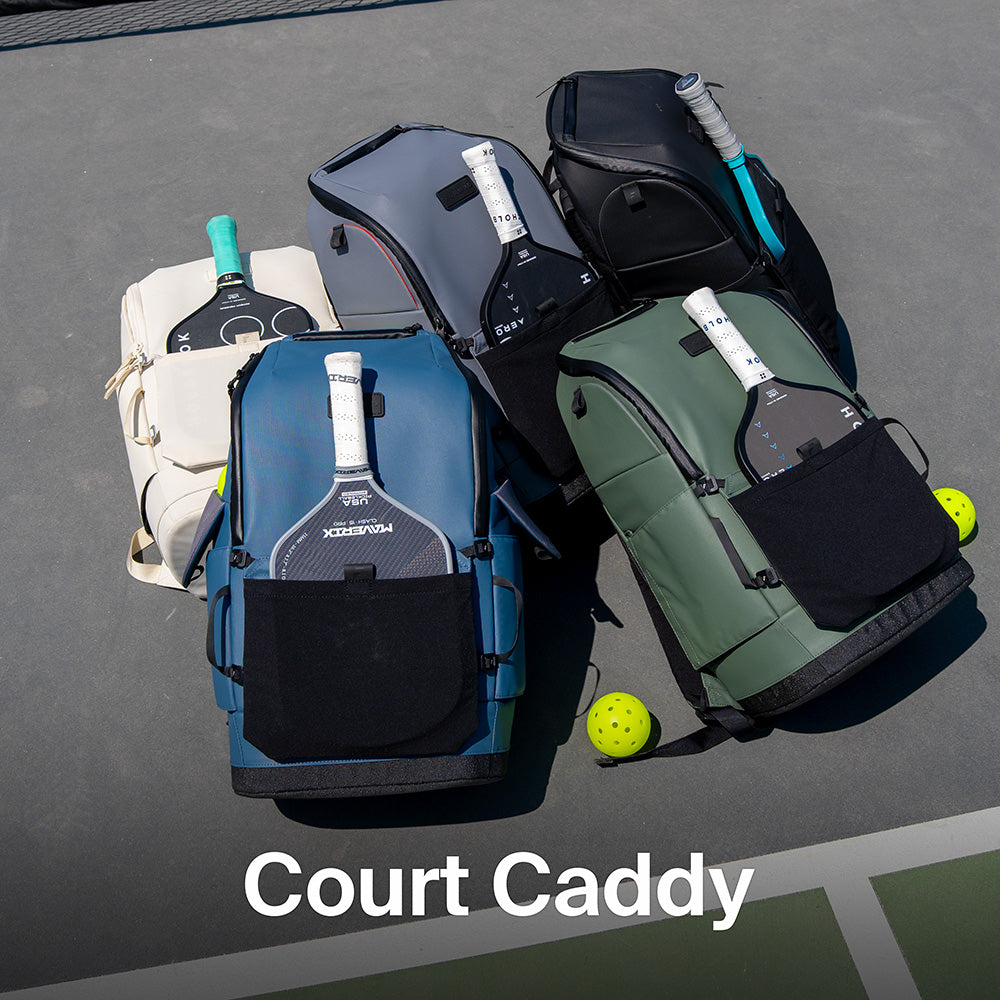
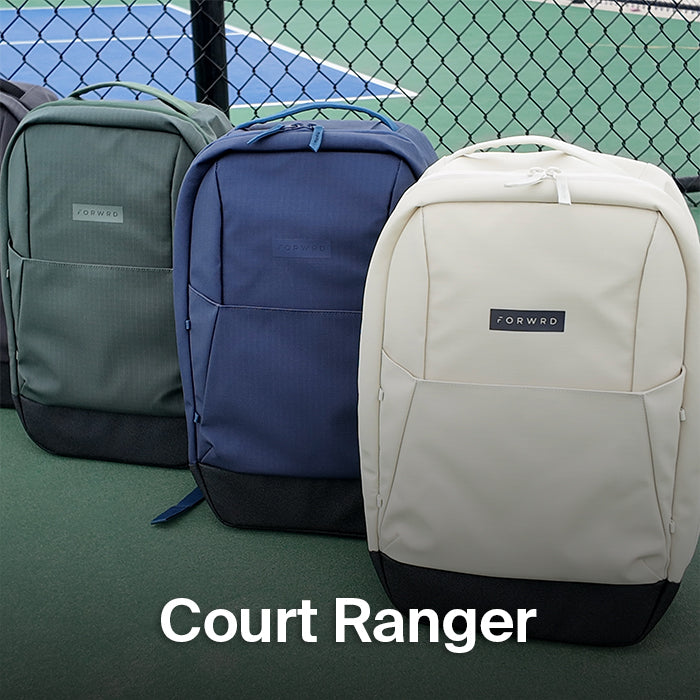
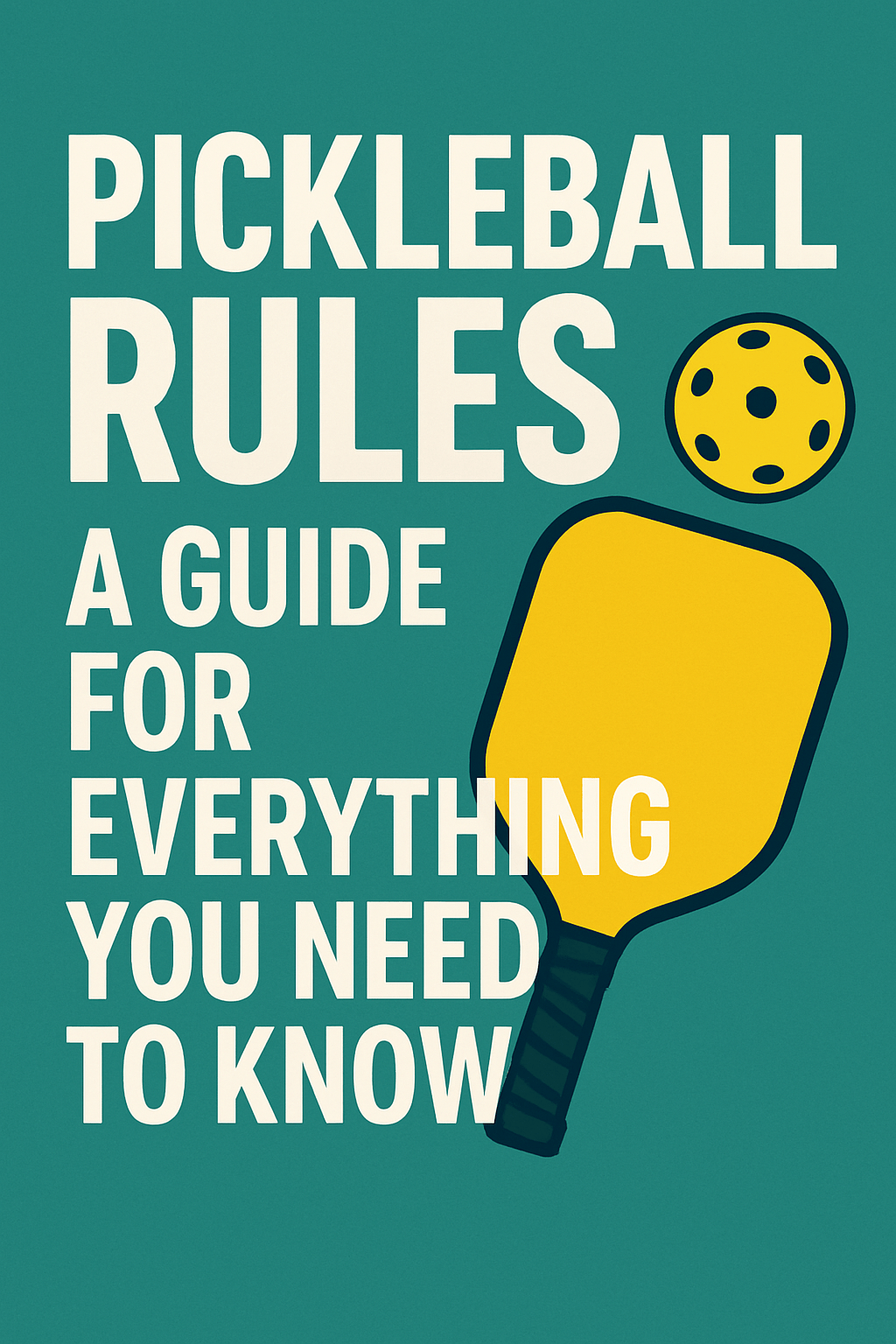
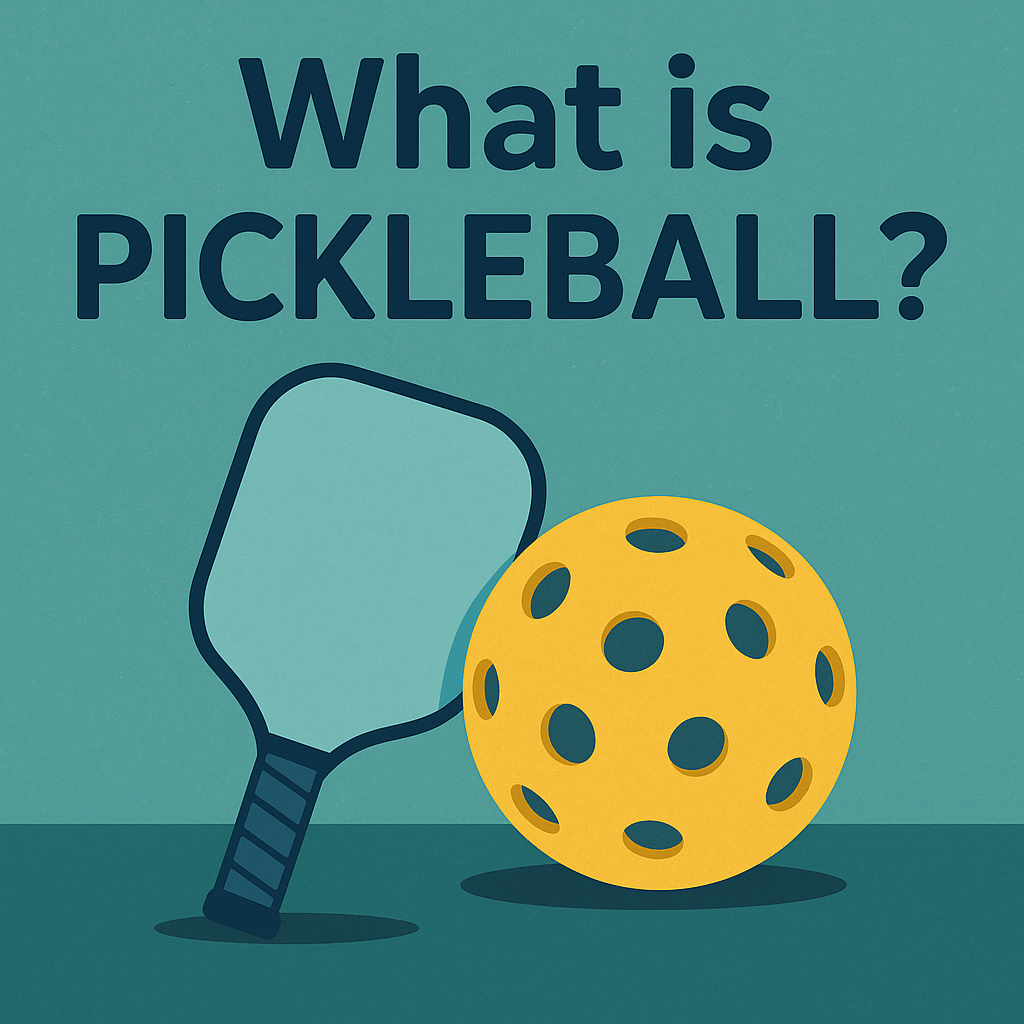
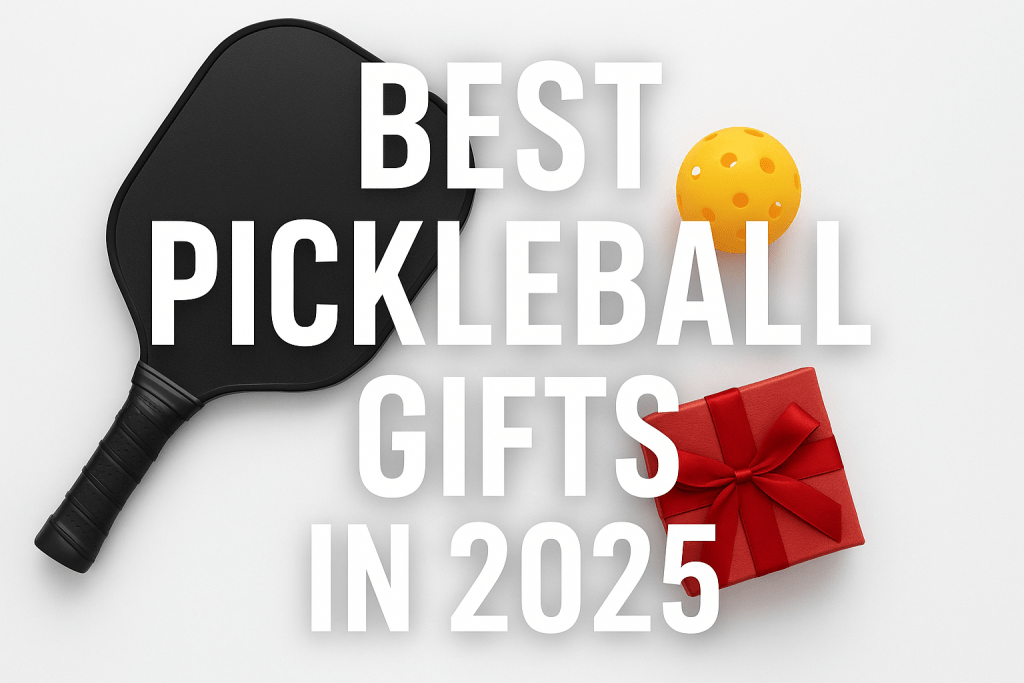
Leave a comment
All comments are moderated before being published.
This site is protected by hCaptcha and the hCaptcha Privacy Policy and Terms of Service apply.